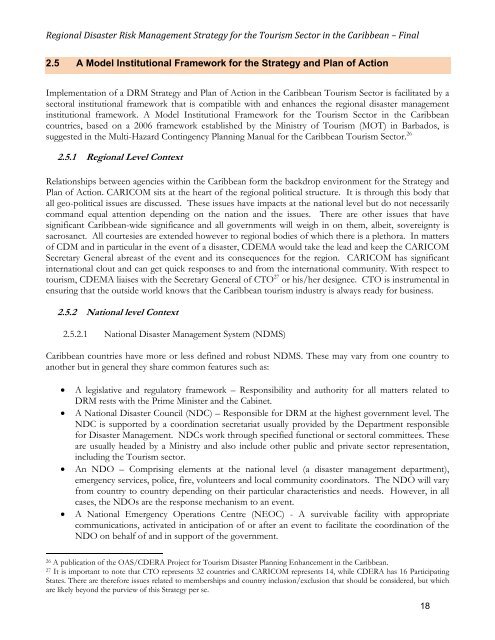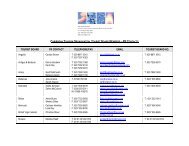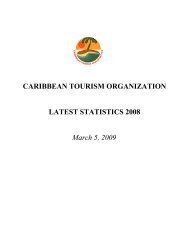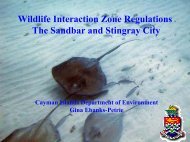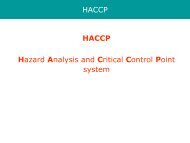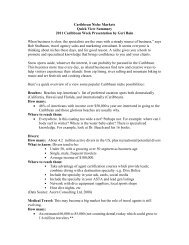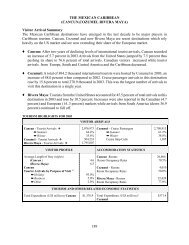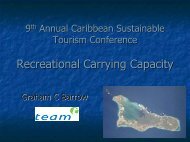Disaster Risk Management Strategy and Plan of Action - Caribbean ...
Disaster Risk Management Strategy and Plan of Action - Caribbean ...
Disaster Risk Management Strategy and Plan of Action - Caribbean ...
You also want an ePaper? Increase the reach of your titles
YUMPU automatically turns print PDFs into web optimized ePapers that Google loves.
Regional <strong>Disaster</strong> <strong>Risk</strong> <strong>Management</strong> <strong>Strategy</strong> for the Tourism Sector in the <strong>Caribbean</strong> – Final<br />
2.5 A Model Institutional Framework for the <strong>Strategy</strong> <strong>and</strong> <strong>Plan</strong> <strong>of</strong> <strong>Action</strong><br />
Implementation <strong>of</strong> a DRM <strong>Strategy</strong> <strong>and</strong> <strong>Plan</strong> <strong>of</strong> <strong>Action</strong> in the <strong>Caribbean</strong> Tourism Sector is facilitated by a<br />
sectoral institutional framework that is compatible with <strong>and</strong> enhances the regional disaster management<br />
institutional framework. A Model Institutional Framework for the Tourism Sector in the <strong>Caribbean</strong><br />
countries, based on a 2006 framework established by the Ministry <strong>of</strong> Tourism (MOT) in Barbados, is<br />
suggested in the Multi-Hazard Contingency <strong>Plan</strong>ning Manual for the <strong>Caribbean</strong> Tourism Sector. 26<br />
2.5.1 Regional Level Context<br />
Relationships between agencies within the <strong>Caribbean</strong> form the backdrop environment for the <strong>Strategy</strong> <strong>and</strong><br />
<strong>Plan</strong> <strong>of</strong> <strong>Action</strong>. CARICOM sits at the heart <strong>of</strong> the regional political structure. It is through this body that<br />
all geo-political issues are discussed. These issues have impacts at the national level but do not necessarily<br />
comm<strong>and</strong> equal attention depending on the nation <strong>and</strong> the issues. There are other issues that have<br />
significant <strong>Caribbean</strong>-wide significance <strong>and</strong> all governments will weigh in on them, albeit, sovereignty is<br />
sacrosanct. All courtesies are extended however to regional bodies <strong>of</strong> which there is a plethora. In matters<br />
<strong>of</strong> CDM <strong>and</strong> in particular in the event <strong>of</strong> a disaster, CDEMA would take the lead <strong>and</strong> keep the CARICOM<br />
Secretary General abreast <strong>of</strong> the event <strong>and</strong> its consequences for the region. CARICOM has significant<br />
international clout <strong>and</strong> can get quick responses to <strong>and</strong> from the international community. With respect to<br />
tourism, CDEMA liaises with the Secretary General <strong>of</strong> CTO 27 or his/her designee. CTO is instrumental in<br />
ensuring that the outside world knows that the <strong>Caribbean</strong> tourism industry is always ready for business.<br />
2.5.2 National level Context<br />
2.5.2.1 National <strong>Disaster</strong> <strong>Management</strong> System (NDMS)<br />
<strong>Caribbean</strong> countries have more or less defined <strong>and</strong> robust NDMS. These may vary from one country to<br />
another but in general they share common features such as:<br />
• A legislative <strong>and</strong> regulatory framework – Responsibility <strong>and</strong> authority for all matters related to<br />
DRM rests with the Prime Minister <strong>and</strong> the Cabinet.<br />
• A National <strong>Disaster</strong> Council (NDC) – Responsible for DRM at the highest government level. The<br />
NDC is supported by a coordination secretariat usually provided by the Department responsible<br />
for <strong>Disaster</strong> <strong>Management</strong>. NDCs work through specified functional or sectoral committees. These<br />
are usually headed by a Ministry <strong>and</strong> also include other public <strong>and</strong> private sector representation,<br />
including the Tourism sector.<br />
• An NDO – Comprising elements at the national level (a disaster management department),<br />
emergency services, police, fire, volunteers <strong>and</strong> local community coordinators. The NDO will vary<br />
from country to country depending on their particular characteristics <strong>and</strong> needs. However, in all<br />
cases, the NDOs are the response mechanism to an event.<br />
• A National Emergency Operations Centre (NEOC) - A survivable facility with appropriate<br />
communications, activated in anticipation <strong>of</strong> or after an event to facilitate the coordination <strong>of</strong> the<br />
NDO on behalf <strong>of</strong> <strong>and</strong> in support <strong>of</strong> the government.<br />
26 A publication <strong>of</strong> the OAS/CDERA Project for Tourism <strong>Disaster</strong> <strong>Plan</strong>ning Enhancement in the <strong>Caribbean</strong>.<br />
27 It is important to note that CTO represents 32 countries <strong>and</strong> CARICOM represents 14, while CDERA has 16 Participating<br />
States. There are therefore issues related to memberships <strong>and</strong> country inclusion/exclusion that should be considered, but which<br />
are likely beyond the purview <strong>of</strong> this <strong>Strategy</strong> per se.<br />
18


